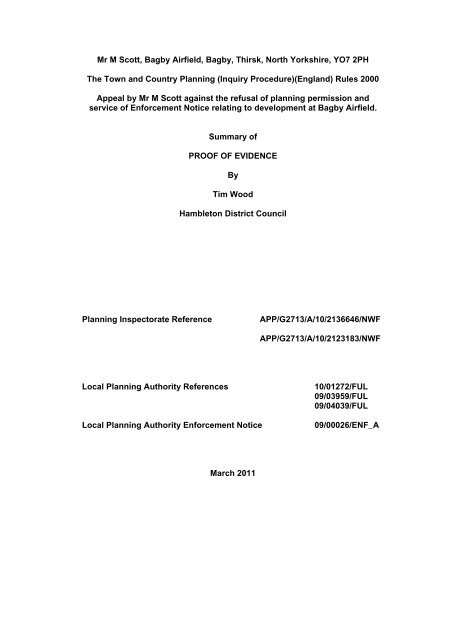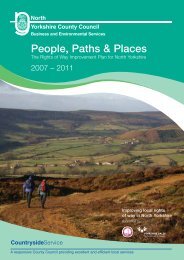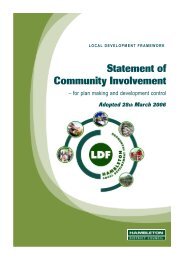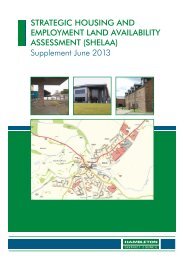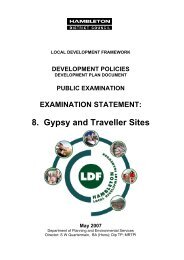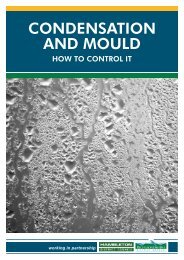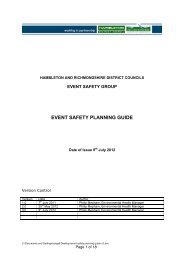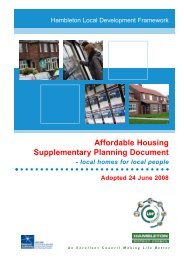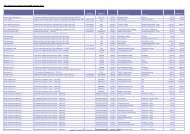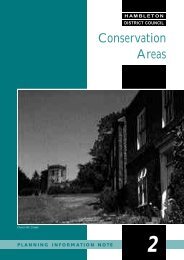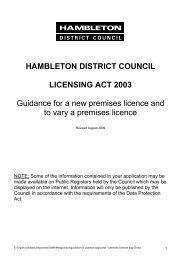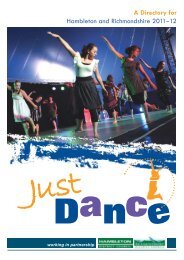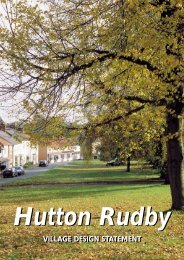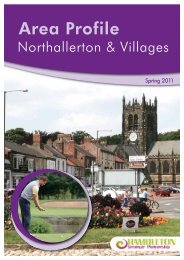Mr M Scott, Bagby Airfield, Bagby, Thirsk, North Yorkshire, YO7 2PH ...
Mr M Scott, Bagby Airfield, Bagby, Thirsk, North Yorkshire, YO7 2PH ...
Mr M Scott, Bagby Airfield, Bagby, Thirsk, North Yorkshire, YO7 2PH ...
You also want an ePaper? Increase the reach of your titles
YUMPU automatically turns print PDFs into web optimized ePapers that Google loves.
<strong>Mr</strong> M <strong>Scott</strong>, <strong>Bagby</strong> <strong>Airfield</strong>, <strong>Bagby</strong>, <strong>Thirsk</strong>, <strong>North</strong> <strong>Yorkshire</strong>, <strong>YO7</strong> <strong>2PH</strong><br />
The Town and Country Planning (Inquiry Procedure)(England) Rules 2000<br />
Appeal by <strong>Mr</strong> M <strong>Scott</strong> against the refusal of planning permission and<br />
service of Enforcement Notice relating to development at <strong>Bagby</strong> <strong>Airfield</strong>.<br />
Summary of<br />
PROOF OF EVIDENCE<br />
By<br />
Tim Wood<br />
Hambleton District Council<br />
Planning Inspectorate Reference<br />
APP/G2713/A/10/2136646/NWF<br />
APP/G2713/A/10/2123183/NWF<br />
Local Planning Authority References<br />
Local Planning Authority Enforcement Notice<br />
10/01272/FUL<br />
09/03959/FUL<br />
09/04039/FUL<br />
09/00026/ENF_A<br />
March 2011
BAGBY AIRFIELD, BAGBY, THIRSK, NORTH YORKSHIRE, <strong>YO7</strong> <strong>2PH</strong><br />
Appeal by <strong>Mr</strong> M <strong>Scott</strong><br />
STATEMENT OF<br />
<strong>Mr</strong>. Timothy J. Wood<br />
on behalf of the Local Planning Authority<br />
Introduction<br />
1. I am Timothy John Wood the Development Manager employed by<br />
Hambleton District Council since 1989 the Local Planning Authority. My<br />
qualifications are BSc (Hons) Environment Planning and I am a member of the<br />
Royal Town Planning Institute.<br />
2. I have been the case officer in connection with this application.<br />
3. My evidence addresses those national and development plan policies and<br />
other material considerations relevant to assessing the merits of the proposed<br />
development. The main issues covered relate to: the impact of the operation of<br />
proposed airfield development on amenity of the neighbouring population, the<br />
lack of support that the proposal would give to sustain the rural community and<br />
the harmful impact of the proposal on the visual amenity of the landscape.<br />
4. York Aviation has been commissioned by the Local Planning Authority to<br />
provide expert advice in relation to General Aviation. The York Aviation<br />
statement is appended to the proof (Appendix 1) and demonstrates that the<br />
unauthorised development will have already given rise to a significant<br />
deterioration in the amenity of the neighbouring population and the proposal has<br />
potential to further harm the amenity of population due to the increased use of the<br />
airfield.<br />
5. Joy Swithenbank, Environmental Health Officer at Hambleton District<br />
Council will appear as an expert witness in relation to noise impacts.<br />
6. I prepared a report to the Planning Committee (Appendix 9 of my proof)<br />
which proposed a grant of planning permission. My professional view has not
changed. As I made explicit in my presentation to members of the Planning<br />
Committee there is more than one means of controlling the future activity at<br />
<strong>Bagby</strong> <strong>Airfield</strong>. Either approval subject to appropriate conditions or refusal of<br />
the planning applications and enforcement of the breaches of planning control<br />
could address the impacts of the current and future operation of the airfield. I<br />
considered a balanced planning judgment was required in determining the<br />
application. On balance, Members of the Planning Committee refused planning<br />
permission and my evidence seeks to explain and support the decision of the<br />
Planning Committee.<br />
The Appeal Site<br />
7. The Appeal Site has an area of 17.82 hectares (44.03 acres). At one time,<br />
the Site was part of an agricultural holding. The extent of land used as the<br />
airfield has changed overtime. The extent of the airfield is shown on plans<br />
appended to my proof. (Appendix 8)<br />
8. The village of <strong>Bagby</strong> is mainly to the north and north east of the appeal site.<br />
There are also dwellings to the south and south west of the appeal site that are<br />
affected by activities at the airfield. A children’s play area is to the north of the<br />
airfield. The surrounding land is in agricultural use.<br />
9. The planning history of <strong>Bagby</strong> <strong>Airfield</strong> starts in 1973 and through the 1970’s<br />
and 80’s buildings and facilities where added to the airfield. During the 1990’s<br />
only one proposal was made for an additional aircraft hangar. Since the<br />
millennium proposals have been made for additional hangar space and since<br />
2008 a series of proposals for comprehensive redevelopment have been made<br />
resulting in the scheme that is now at appeal.<br />
10. A planning Enforcement Notice was served in 2009 following a breach of<br />
planning control in respect of the construction of an aircraft hangar and hard<br />
surfacing of the runway and aprons to hangars and the provision of matting on<br />
the east west runway.
The Appeal Proposals<br />
11. The appeal proposal is a comprehensive scheme to demolish all of the old<br />
buildings on the Site except for the largest aircraft hangar and replace them with<br />
a new range of hangars and a new clubhouse and form a new access to the site.<br />
A new refuelling point for helicopters and the retention of runway matting and<br />
hard-surfacing is also included. Two modern hangars will also be retained. The<br />
scheme would result in a mixed use development comprising airfield club house<br />
and other airfield facilities including aircraft maintenance.<br />
12. The application 10/01272/FUL was refused planning permission on 3<br />
September 2010 for the following reasons<br />
1. The proposal is contrary to PPG24 and the Local Development Framework<br />
Policies CP1, DP1, CP4, CP21 and DP44 as the proposed development<br />
would give rise to a number of aircraft movements at the airfield that would<br />
fail to adequately protect or enhance the amenity of the population,<br />
particularly with regard to noise and disturbance as required by Policy DP1.<br />
2. The proposal is contrary to PPS4 and the Local Development Framework<br />
Policies CP1, CP2, CP4 and DP25 as it has not been supported by a<br />
business case that demonstrates that support will be provided to the local<br />
economy which in turn would help sustain rural communities.<br />
3. The proposal is contrary to PPS1 and PPS7 and the Local Development<br />
Framework Policies CP16 and DP30 as the proposal would have a harmful<br />
impact on the visual amenity of the landscape.<br />
13. A synopsis of the planning history is contained in appendix 2 to the proof.<br />
14. The appeal proceedings also relate to 2 applications refused in 2009 for<br />
matting and concrete surfacing and a refuelling facility and an appeal against the<br />
2009 Enforcement Notice.
Planning Policy<br />
15. National and Local policies relating to the appeals are as follows<br />
Table 1 National and LDF Policies<br />
National policies Hambleton Local<br />
Development Framework<br />
• PPS1<br />
Core Strategy<br />
• PPS4<br />
• PPS7<br />
Policies<br />
CP1<br />
CP2<br />
CP4<br />
CP15<br />
CP16<br />
CP21<br />
• PPG13<br />
• PPG18<br />
• PPG24<br />
Development<br />
Policies<br />
DP1<br />
DP25<br />
DP30<br />
DP44<br />
Plan<br />
16. PPS1 requires Planning Authorities to promote sustainable development<br />
and amongst other things requires protection of the environment, good design to<br />
reduce the nee for travel. PPS4 requires Local Planning Authorities to adopt a<br />
positive approach towards Economic Development. A series of tests are set<br />
relating to carbon dioxide emission limits and resilience to climate change,<br />
accessible transport systems (also included in PPG13), high quality design,<br />
development that meets local economic and social objectives, finally considering<br />
the impact on local employment. PPS4 acknowledges that new employment in<br />
the countryside can be the most sustainable option and that not all new<br />
employment development should or could be in the most accessible locations.
17. PPS7 relates to Sustainable Development in Rural Areas whilst much of its<br />
content in respect of economic development has been replaced by PPS4 it<br />
requires landscape protection and protection of the environment.<br />
18. PPG13 sets out the Governments policy on transport. It promotes<br />
sustainable transport, accessible and safe, a reduction in the need for travel<br />
especially the reliance on the car. Planning authorities are to recognise that<br />
small scale developments in the countryside may still be acceptable. PPG13<br />
does not provide detailed specific guidance on General Aviation matters.<br />
19. PPG18 guides the approach to be taken on Enforcing Planning Control and<br />
has informed the approach of the Council.<br />
20. PPG24 advises at paragraph 2 “The impact of noise can be a material<br />
consideration in the determination of planning applications.” PPG24 provides on<br />
the noise impacts from aviation sources and at paragraph 10 “requires that “local<br />
planning authorities must ensure that development does not cause an<br />
unacceptable degree of disturbance. They should also bear in mind that a<br />
subsequent intensification or change of use may result in greater intrusion and<br />
they may wish to consider the use of appropriate conditions.”<br />
21. The Local Development Framework sets the planning policies for<br />
Hambleton. For new development in rural locations policies CP1, CP2, CP4<br />
advise on matters of principle. From the Strategic Objectives that includes: “to<br />
ensure that all development is sustainable, enabling people to satisfy their basic<br />
needs and enjoy a better quality of life, without compromising the quality of life of<br />
future generations” this message is of protecting amenity is reinforced through all<br />
of the LDF particularly in respect of amenity in Core Strategy CP1 and<br />
Development Policies DPD DP1.<br />
22. CP15 and DP25 provide policy on employment development and the<br />
approach to be taken. CP16 and DP30 set policy on landscape issues and CP21<br />
and DP44 on protecting population from the effect of noise. These follow the<br />
National policy of Government and give it local relevance.<br />
23. The Lawful Use of the airfield is explained with reference to the history of<br />
built development, engineering works and uses found at the airfield for a
continuous 10 year period. Written evidence of the airfield is limited, physical<br />
evidence on site provides some detail and assessment of current activity is also<br />
informative.<br />
24. Whilst the burden of proof in demonstrating a lawful use rest with the<br />
appellant certain information has been establish. The lawful use of <strong>Bagby</strong><br />
<strong>Airfield</strong> is as an airfield subject to the limitations of the physical extent, condition<br />
and facilities at the airfield and those uses and activities that have existed<br />
throughout a 10 year period.<br />
25. There has been continuous use of the land as an airfield for more than 10<br />
years. It has some hangars, a club house facility and refuelling point, and other<br />
facilities, some with the benefit of planning permission and some without, some<br />
may be immune and some may not require planning permission.<br />
26. The statement by York Aviation and the methodology they advise regarding<br />
splits in summer and winter flying allows a conclusion to be reached on the lawful<br />
flight numbers which exclude the club fly-in days.<br />
Table 2 Lawful flight numbers<br />
Weeks in season Aircraft movements Adjustments in<br />
proportion of<br />
flights by season<br />
Summer 30 3342 100%<br />
Winter 22 1225 50%<br />
Annual total 52 4567<br />
27. There are 3 issues pertinent to this appeal – amenity, business case and<br />
landscape.<br />
28. The amenity impacts particularly of aircraft take-off and landing are severe,<br />
it harms the peace and tranquillity for residents of <strong>Bagby</strong> and the other the<br />
neighbouring villages and isolated dwellings.
29. The movements of large numbers of aircraft in fine summer weather<br />
conditions, when residents are enjoying outdoor leisure time appears most<br />
harmful to amenity; this impact is especially significant when larger helicopters<br />
are involved. The early or late flying of aircraft have been reported to wake<br />
people in houses in <strong>Bagby</strong> and is a clear demonstration of an impact that is<br />
unacceptably affecting the amenity of the local community contrary to National<br />
and LDF policies.<br />
30. The lack of a business case prevents a full understanding of the impact of<br />
the scheme on the local economy. Without proper detail the scheme can not be<br />
shown to contribute to the Governments objectives for a sustainable economy or<br />
assist in the growth of the rural economy and may harm other local business due<br />
to the noise impacts arising from the airfield.<br />
31. The landscape impacts of the proposal would be to cause harm to the<br />
visual amenity of the landscape as the new structures proposed would be visually<br />
intrusive from vantage points around the airfield and would not be readily<br />
assimilated within the landscape. Movement of aircraft draws the eye to the<br />
airfield and the mitigation planting scheme proposed would be unable to address<br />
all of the impacts.<br />
32. Planning conditions have been proposed to assist the Inspector and without<br />
prejudice to the case made in the proof of evidence. These are in a Statement of<br />
Common Ground and are to address the impacts and help to achieve compliance<br />
with the National and Local policies and circumstances of the site as noted in the<br />
written evidence and as may be heard at the Inquiry.<br />
33. An Enforcement Notice was served in 2009 in respect of hard-standing,<br />
matting and a new hangar at the airfield. The impacts of these unauthorised<br />
works are common to the impacts from the comprehensive scheme. Removal of<br />
the unauthorised works is necessary to restore the airfield to its former lawful<br />
condition and to address the harmful impacts which have arisen. The Council<br />
consider that a 3 month period is sufficient to undertake the necessary works.
Conclusion<br />
34. The proposed development is considered to be contrary to both National<br />
Planning Policy and Guidance and that contained within the Hambleton Local<br />
Development Framework. The development would, as set out in the decision<br />
notices, cause harm to the amenity of residents, the landscape and this is not<br />
offset by any economic benefits.<br />
35. In addition the works undertaken in breach of planning control, and the<br />
subject of the Enforcement Notice, cause actual harm to the resident population<br />
due to the disturbance caused by operations at the airfield and the visual<br />
intrusion of the development in the countryside.<br />
36. The harm arising from both the development in the Planning Applications<br />
and in the Enforcement Notice can not be overcome by the imposition of<br />
conditions.<br />
37. In the light of the above considerations, the appointed Inspector will be<br />
respectfully requested to dismiss the appeals.


